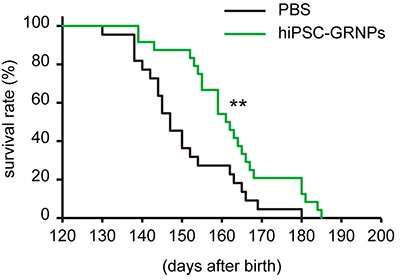Transplantation of human iPS cell-derived glial-rich neural progenitor cells into ALS model mice extends their lifespans

A research group led by Dr. Haruhisa Inoue, Professor of the Center for iPS Cell Research and Application (CiRA), Kyoto University, and Researcher Dr. Takayuki Kondo of CiRA discovered that the transplantation of human iPS cell-derived glial-rich neural progenitor cells into amyotrophic lateral sclerosis (ALS) model mice extended their lifespans.
It is known that the transplantation of mouse and human fetus derived neural progenitor cells into the SOD1 gene mutation-induced ALS model mice delays the degeneration of motor neurons and pathological progression. To apply this to clinical cases, it was necessary to perform studies with human cells that can be continuously supplied.
Inoue's group established a differentiation protocol of glial-rich neural progenitor cells, which are neuronal precursors of the glial lineage, from human iPS cells and transplanted them into the lumbar cord of the ALS model mice. The transplanted cells differentiated into astrocytes, and the survival time of mice with the graft was extended compared to that of those without the graft. It was also suggested that the transplanted cells improve the spinal cord environment by increasing neurotrophic factors. These findings suggest the possibility of treating ALS patients with cell transplantation using human iPS cells.
ALS is a progressive disease in which motor neurons become dysfunctional and muscles become unable to move. Studies on the treatment of ALS are roughly divided into 2 strategies. One is to reproduce the pathology of ALS and search for a therapeutic drug to improve it. The other is the complementation and regeneration of motor neurons with ALS, which have lost their function to appropriately stimulate muscle, by cell transplantation. Employing the latter strategy, the research team reported that therapeutic effects, including extension of the survival time, can be expected to some extent through the transplantation of the human iPS cell-derived glial-rich neural progenitor cells (hiPSC-GRNPs), many of which differentiated into astrocytes after transplantation.
Neurotrophic factor is important in the pathology of ALS, and it is being investigated worldwide as a target of treatment. Inoue's study demonstrated that neurotrophic factor increased with the cell transplantation treatment and that the spinal cord environment in the ALS model mice was improved.
Cells of the glial lineage have a function to prepare the environment around nerve cells. Assuming that healthy motor neurons are flowering plants, cells of the glial lineage play the role of the soil supplying nutrients required for the flowers to bloom. However, it is difficult to replant withering plants, i.e., regenerate lost motor neurons. In this study, the team started by supplementing with good soil, which are human iPS cell-derived glial-rich neural progenitors. In order to regenerate diseased motor neurons, it is necessary not only to supply good soil but also to replant plants themselves. In the future, the transplantation of healthy motor neurons may more efficiently recover the function, but many issues remain to be overcome, and a lot of time is necessary before reaching the stage of investigating the therapeutic effects in humans.
More information: "Focal Transplantation of Human iPSC-Derived Glial-Rich Neural Progenitors Improves Lifespan of ALS Mice." Takayuki Kondo, Misato Funayama, Kayoko Tsukita, Akitsu Hotta, Akimasa Yasuda, Satoshi Nori, Shinjiro Kaneko, Masaya Nakamura, Ryosuke Takahashi, Hideyuki Okano, Shinya Yamanaka, Haruhisa Inoue. Stem Cell Reports (2014) DOI: dx.doi.org/10.1016/j.stemcr.2014.05.017



















